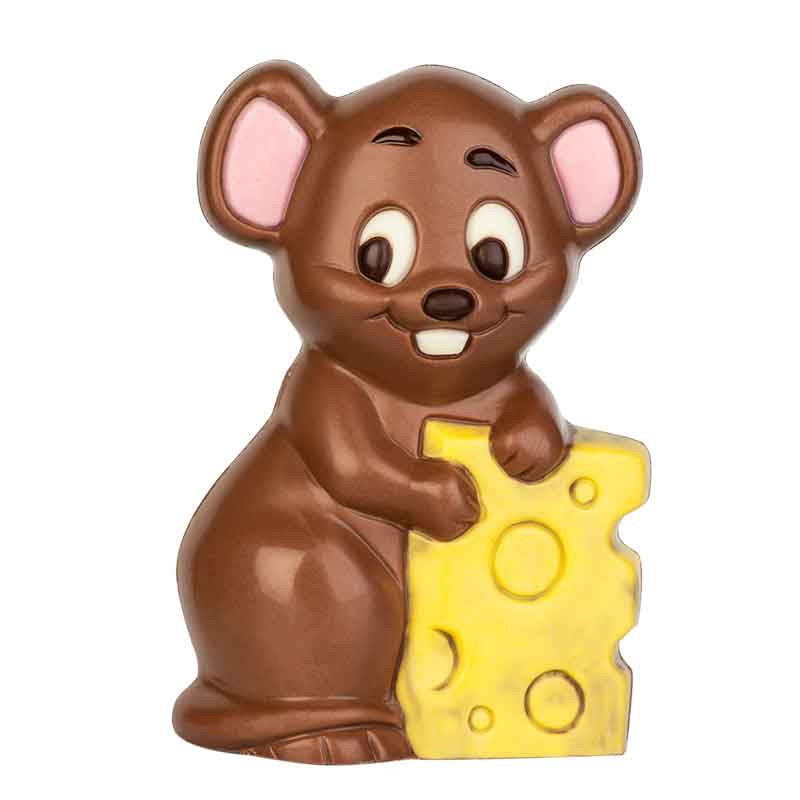



Making a sweet cheese mouse yourself is no problem with the high-quality polycarbonate mold. With different colors and make-up ideas, your very own chocolate figure is created.
Data sheet
Chocolate figurines are perfect gifts. At Easter, chocolate Easter bunnies line the shelves of major distributors, and in the run-up to Christmas, hundreds of chocolate Sami lice are sold. As an alternative to the Samichläuse and bunnies, or simply as a special gift, chocolate animal figurines are particularly suitable. To make one is not difficult, so they can be poured even with children.
Here is the cheese in good paws. The little cheese mouse smiles happily at the conquered prey and so certainly makes you smile too. The little mouse can be poured with a few couverture colors. The cheese comes out best when yellow cocoa butter or some yellow colored couverture is used.
For all molds used for chocolate molding, preparation is extremely important. Rinse the mold with lukewarm water and a gentle rinsing agent. This must not contain lye or rinse aid, as this would corrode the molds. Then rinse off all residues with lukewarm water and dry the mold very well. From now on, you should not touch the mold directly, otherwise fingerprints will be visible on the chocolate later. Hold the mold at the edge where no chocolate will be poured later. Polish the mold with a non-fibrous absorbent cotton or a very fine handkerchief.
To make chocolate figures, you should only use high-quality, tempered couverture. Chocolate from the supermarket will not be liquid enough and will not produce the desired quality. For tempering, it is best to use a Temperature control unit, You can also make a water bath. Be careful that in no case water gets into the chocolate. This would make it crumbly and lumpy.
Now you can start with the make-up. For this you can colored cocoa butter or tempered couverture. You can also use white couverture with fat soluble powder colors for coloring chocolate. For a beige color, mix 1/3 milk couverture with 2/3 white couverture. For this, both couvertures must be tempered and not mixed for too long, otherwise they will cool down considerably.
Take the tempered couverture or some melted cocoa butter and start with the outermost layer. Chocolate molds must be painted from the outside in, which means that what is painted first will later be visible from the outside. The best way to apply the compound is with a fine brush, a sponge or by hand. It is important that all materials are clean, dry and free of grease. If you want to draw a pattern with your fingers, you must wear plastic gloves. Otherwise your fingerprints will be visible later. Once the couverture or cocoa butter has dried slightly, apply the next layer. In this way, you work your way inwards. While applying the make-up, you can occasionally turn your form over. This way you can see what your final product will look like.
Once you are satisfied with all the colored details, you let the whole thing tighten again briefly. Then take a larger brush. With this brush, you now brush the entire form with couverture. Use the couverture that you want your product to have in the end. Turn the mold over and over again. No more air bubbles should be visible, otherwise they would be visible as holes in the finished mold. Use a metal horn to remove chocolate from the surface of the mold. Then put the mold halves on top of each other and fasten them well with the provided clamps. If you are sure that the halves do not slip, you can fill the mold completely with couverture. It is best to use a soup ladle for this. Use the handle of a spatula to tap the edge of the mold so that any air bubbles rise.
Then invert the mold over your couverture bowl, continue tapping the rim with the spatula, and wait for the excess couverture to run out. If you notice that the resulting wall is a little too thin, simply repeat the filling and emptying process. Then wipe off the bottom drops with the metal horn and place the mold in the refrigerator for 2-5 minutes.
During this you can prepare the bottom of the mold. On a clean baking paper you spread a little couverture. Now press the cooled mold well into it. Put the mold and the baking paper together in the refrigerator for another 10 - 15 minutes and after removing the clamps for another 10 - 15 minutes. Then take the mold out of the refrigerator, break off the excess and shape the figure. To do this, carefully insert a spatula into the gap between the mold halves and move it slightly. Be careful, the molds loosen quickly and the figure should not fall off immediately or be damaged by the spatula. The chocolate figurine can now be decorated with fondant, sugar decorations or similar and then wrapped in a noble package.
As a great experience for the whole family or for making extraordinary gifts are suitable our Figure casting courses perfect. At miniSchoggi, you'll learn how to properly polish polycarbonate molds, make them sweet, and pour them out nice and thin. You will learn all this from trained confectioners who can also answer difficult questions. In this way, young and old can create colorful and elegant chocolate figures. Children as young as 8 can take part and make a very special Easter bunny or Santa Claus - so you can enjoy a particularly magical Advent season and sweeter Easter than ever before.
Make up and pour at miniSchoggi the own Santa Claus or Easter bunnies!

Making a sweet cheese mouse yourself is no problem with the high-quality polycarbonate mold. With different colors and make-up ideas, your very own chocolate figure is created.